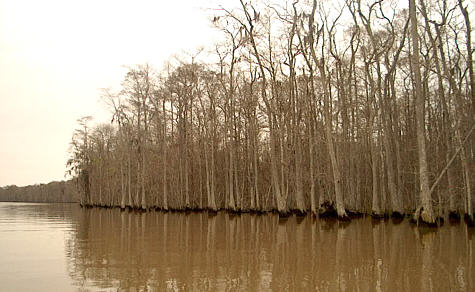|
By the time I reached the end of the Barataria and the open Gulf the seas were about 2 ft. If you have read some of my other tales you know in these conditions Therapy’s 11 degrees of deadrise at the transom delivers a somewhat harsh ride if I try to push a much speed. I had planned to stop at Grand Isle and check things out but decided to instead to head back to more protected waters before things got any worse. I used the trim tabs to force the bow down and could maintain about 12 to 14 mph without causing too much kidney damage.
Once in the sheltered waters the return trip passes quickly. I again am able to squeeze under the swing bridge and after a fuel stop to top off the tanks return to the westward track on the Gulf Intracoastal Waterway. Using Quimby’s I note that the next services are in Houma, LA at the 57.7 mm, which is about an hour and a half away. The terrain along this section on the ICW is fairly consistence. Low shore lines with trees draped in moss, wide blade grasses and other rather rugged looking plant life. Even though it was the end of January I had for some reason expected things this far south to be green, but no, just like home most of the countryside was brown and bleak.
There is a heavy traffic traveling this section of the Waterway. Although the tows and barges are not near the size of the Mississippi River tows they are still very numerous. Rarely is there over a two-mile stretch where I don’t pass at least one tow lumbering along with its burden. At times there are three or four in sight. Fortunately, because of their smaller size and low current, the wake they produce is manageable and confined to their local vicinity. Passing is not a problem unless there is traffic from the opposite direction.
I had decided to try to spend the night at Morgan City, LA located at the 95 mm. There Quimby’s list a municipal dock and a fuel dock, plus the GPS shows a few restaurants with in walking distance. There are a few obstacles between here and there but making the dock by dark should be no problem.
Mileage markers are scarce along this portion of the GIWW but following the correct course is no problem even though there seems to be water everywhere. Canals run off the main channel going in all directions. Some are private and gated and many straight as an arrow for miles. There are very few signs of any human intervention in most of this area. I had to chuckle at around the 65 mm because there, in the middle of nowhere, stands a large billboard hawking services of a personal injury law firm specializing in services to sailors. Even out here you can’t escape the litigious society into which we have evolved.
|
 A
few miles farther and the developed shoreline subsided and areas of
swamp grass and marsh began defining the waterway channel.
For a while it remained somewhat narrow and river like but then breaks
began to appear offering more open water. The farther south
the larger these grew and now the wind had picked up and the waves were
at about a foot and starting to break.
A
few miles farther and the developed shoreline subsided and areas of
swamp grass and marsh began defining the waterway channel.
For a while it remained somewhat narrow and river like but then breaks
began to appear offering more open water. The farther south
the larger these grew and now the wind had picked up and the waves were
at about a foot and starting to break.  The
waves were quartering off the bow and from time to time caused spray
that went completely over the pilothouse. Normally I don’t
mind this too much but this is salt water and I hate the mess it makes.
I had hoped to avoid this as my normal post trip wash down
and clean up will be made more difficult by the below freezing
temperatures at home. Little I can do about it and continued
to plow along.
The
waves were quartering off the bow and from time to time caused spray
that went completely over the pilothouse. Normally I don’t
mind this too much but this is salt water and I hate the mess it makes.
I had hoped to avoid this as my normal post trip wash down
and clean up will be made more difficult by the below freezing
temperatures at home. Little I can do about it and continued
to plow along. I
approach the marina at Houma, which is directly off channel on my
starboard. It looks like a nice facility with boats moored
along the narrow channel. The GPS’s “points of interest”
database indicated a couple of possible eating establishments in the
area but I had my lunch sandwich a little while earlier and
continue.
I
approach the marina at Houma, which is directly off channel on my
starboard. It looks like a nice facility with boats moored
along the narrow channel. The GPS’s “points of interest”
database indicated a couple of possible eating establishments in the
area but I had my lunch sandwich a little while earlier and
continue.